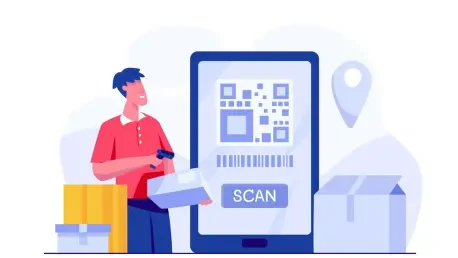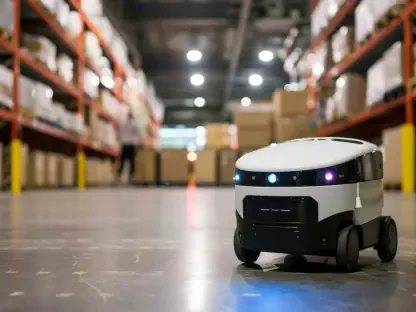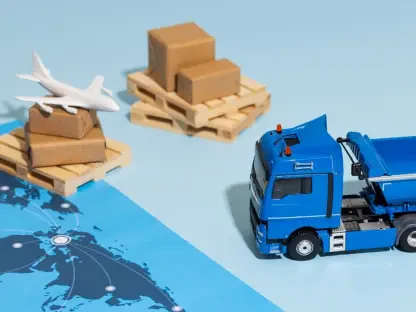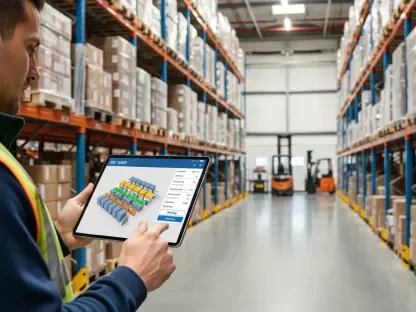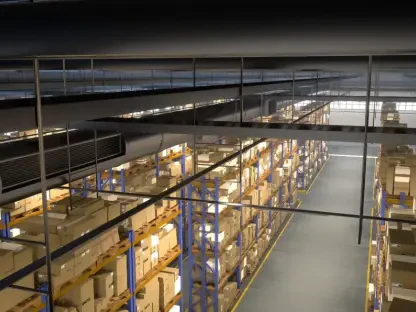Picture a future where every shipment, from a small online order to a massive industrial pallet, communicates its journey in real-time—revealing its exact location, condition, and estimated arrival with flawless precision. This isn’t a distant dream but a transformation already underway in the logistics industry, powered by smart labeling technologies. With the market valued at USD 7.7 billion in 2025 and projected to surge to USD 12.6 billion by 2035 at a steady 5.0% compound annual growth rate, the impact of intelligent labels is undeniable. Technologies like RFID (Radio Frequency Identification), NFC (Near Field Communication) tags, and sensor-enabled QR codes are redefining supply chains, offering dynamic insights far beyond the capabilities of traditional barcodes. From retail to pharmaceuticals, these innovations promise to enhance transparency, reduce errors, and meet the ever-growing demands of global trade. As this evolution accelerates, the logistics landscape is set to become smarter, faster, and more connected over the next decade.
The Driving Forces Behind Smart Labeling
Automation and Real-Time Tracking as Game Changers
The logistics sector is undergoing a seismic shift, largely fueled by the urgent need for automation and real-time tracking capabilities. Smart labels, integrated with Internet of Things (IoT) devices, enable businesses to monitor shipments and inventory with unprecedented accuracy. This technology provides instant updates on a package’s location and status, significantly reducing human error and speeding up operational processes. Unlike static barcodes, smart labels capture live data on variables like temperature or vibration, allowing companies to address issues before they escalate. In industries such as e-commerce and cold chain logistics, this means fewer delays and better resource allocation. The drive for automation isn’t just about efficiency—it’s about staying competitive in a world where speed and precision are paramount. As more companies adopt these systems, the ripple effect is felt across global supply chains, setting a new standard for operational excellence.
Another critical aspect of automation lies in its ability to support predictive decision-making, a feature that smart labeling uniquely enables. By collecting and analyzing data in real-time, these labels help logistics managers anticipate disruptions, optimize routes, and manage inventory levels proactively. For instance, in retail, knowing the exact status of incoming stock prevents over-ordering or stockouts, directly impacting profitability. This predictive edge is particularly vital in high-stakes sectors like pharmaceuticals, where delays or spoilage can have serious consequences. The integration of smart labels with digital platforms further amplifies this capability, creating a seamless flow of information across networks. As businesses scale up, the reliance on such automated insights will only deepen, transforming logistics from a reactive process into a forward-thinking operation by 2035.
Regulatory Compliance and Consumer Demands
Regulatory compliance stands as a powerful motivator for adopting smart labeling, especially in sectors where safety and traceability are non-negotiable. In food and pharmaceutical logistics, strict guidelines mandate detailed tracking of goods to ensure quality and prevent fraud. Smart labels, equipped with tamper-evident features and authentication mechanisms, meet these requirements by providing an unbroken chain of custody from origin to destination. This is crucial for cross-border shipments, where verifying product integrity can mean the difference between market access and costly rejections. Governments and industry bodies worldwide are tightening these rules, pushing companies to invest in technologies that guarantee compliance. As a result, smart labeling is becoming less of an option and more of a baseline necessity for operating in regulated markets.
Beyond regulations, consumer expectations are reshaping how logistics functions, particularly in the booming e-commerce space. Today’s shoppers demand transparency—real-time delivery updates and proof that products are genuine. Smart labels bridge this gap by offering scannable data that confirms authenticity and tracks a package’s journey, directly enhancing customer trust. This shift is evident in retail, where brands use NFC tags to let consumers verify high-value items like luxury goods. Such transparency doesn’t just satisfy curiosity; it builds loyalty in a competitive market where trust is currency. As consumer awareness grows, companies ignoring this trend risk losing ground to rivals who prioritize visibility. By 2035, smart labeling could well become a key differentiator, turning backend logistics into a customer-facing asset that drives satisfaction and repeat business.
The Technological and Regional Landscape
Core Technologies and Market Dominance
At the heart of smart labeling lies a robust ecosystem of hardware and software, with hardware components like RFID readers, scanners, and printers commanding a significant 44.2% market share in 2025. These tools form the critical bridge between physical goods and digital systems, making them indispensable in warehouses, fulfillment centers, and transport hubs. RFID labels, in particular, dominate the product segment with a 48.5% revenue share, thanks to their superior ability to handle bulk scanning and store complex data. Unlike traditional barcodes, they don’t require line-of-sight scanning, which speeds up processes in high-volume environments. Their durability also makes them ideal for harsh conditions in industrial logistics. As technology advances, the cost of these solutions is expected to decrease, broadening their adoption across smaller enterprises and paving the way for widespread transformation by 2035.
Deployment trends further highlight the industry’s direction, with cloud-based solutions leading at 53.1% of the market in 2025. These systems offer unmatched scalability and real-time data integration, syncing seamlessly with enterprise platforms to provide a centralized view of operations. This is especially valuable for multinational companies managing complex, global supply chains. In terms of applications, logistics and supply chain visibility reigns supreme, accounting for 35–40% of use cases. The need for precise parcel tracking and shipment authentication drives this dominance, particularly in e-commerce and retail. Other sectors, like healthcare and food logistics, are also catching up, fueled by compliance needs and the demand for condition monitoring. As cloud technology evolves, its role in unifying data across diverse applications will likely cement smart labeling as a cornerstone of logistics innovation over the coming years.
Regional Variations in Growth and Adoption
Globally, the appetite for smart labeling is undeniable, yet adoption patterns differ based on local priorities and economic conditions. China leads the charge with a projected growth rate of 6.8% annually, driven by its massive e-commerce sector and increasing use of sensor-equipped labels in pharmaceuticals. The country’s focus on scalability and cost-effective solutions fuels rapid deployment, positioning it as a frontrunner in market expansion. India follows closely with a 6.3% growth rate, leveraging smart labels to tackle counterfeiting in fast-moving consumer goods and cold chain logistics. Government initiatives to enhance traceability in these sectors further accelerate uptake. Both nations illustrate how emerging markets can leapfrog traditional systems by prioritizing innovative, affordable technologies tailored to their unique challenges.
In contrast, developed regions exhibit distinct focuses shaped by advanced infrastructure and regulatory landscapes. Germany, with a 5.8% growth rate, harnesses smart labels for automotive and industrial logistics, supported by stringent compliance frameworks. France, at 5.3%, emphasizes cold chain transparency and authentication for luxury goods, reflecting its niche market priorities. The USA, growing steadily at 4.3%, integrates smart labeling into e-commerce fulfillment and large-scale warehouse automation, capitalizing on existing technological maturity. These variations underscore how regional dynamics—whether economic scale, consumer behavior, or legal mandates—shape the trajectory of smart labeling. By 2035, such diversity in adoption will likely create a mosaic of specialized applications, enriching the global logistics ecosystem with tailored solutions.
Challenges and Horizons Ahead
Barriers to Seamless Integration
Despite its transformative potential, smart labeling faces significant hurdles that could slow its widespread adoption. One major challenge is the high initial cost of implementation, which remains a barrier for smaller businesses or those in price-sensitive markets. While prices for RFID tags and hardware are gradually declining, the upfront investment in infrastructure—such as readers and software integration—can still be daunting. This financial obstacle often delays adoption, particularly in regions or industries with tight budgets. Additionally, the return on investment may not be immediately clear to stakeholders unfamiliar with long-term benefits like reduced losses or improved efficiency. Addressing this cost concern through subsidies, scalable solutions, or phased rollouts will be crucial to democratizing access to smart labeling technologies over the next decade.
Another pressing issue lies in the lack of standardization and interoperability across systems, which complicates integration into existing logistics frameworks. Different manufacturers and regions often use proprietary formats or protocols, leading to compatibility issues when goods move across borders or between partners. This fragmentation can result in data silos, undermining the very transparency smart labels aim to provide. Moreover, the environmental impact of electronic labels raises concerns, as recycling options for components like RFID inlays are limited. Manufacturers face pressure to develop eco-friendly alternatives without sacrificing performance. Overcoming these technical and sustainability challenges will require collaborative efforts among industry players, regulators, and innovators to establish universal standards and sustainable practices by 2035.
Emerging Opportunities and Future Vision
On the flip side, the horizon for smart labeling brims with opportunities, particularly in the realm of sensor-equipped labels tailored for specialized logistics needs. These advanced labels, capable of monitoring conditions like temperature and humidity, are game-changers for cold chain management in food and pharmaceutical sectors. They enable real-time alerts for deviations, preventing spoilage and ensuring compliance with safety standards. Beyond monitoring, integration with IoT opens doors to predictive routing and automated interventions, allowing logistics systems to reroute shipments or address issues proactively. Such capabilities enhance supply chain resilience, a critical asset in an era of global disruptions. As sensor technology becomes more affordable, its adoption is expected to skyrocket, redefining how sensitive goods are handled.
Looking further ahead, the convergence of smart labeling with artificial intelligence and cloud connectivity paints a compelling picture for 2035. AI-driven analytics can process the vast data generated by smart labels to uncover patterns, optimize operations, and forecast demand with remarkable accuracy. Cloud systems, already dominant in deployment models, will continue to evolve, offering even greater scalability and accessibility for businesses of all sizes. This synergy promises to turn logistics from a traditionally opaque process into a fully transparent, consumer-centric operation. High-value goods tracking, last-mile delivery precision, and customer trust will all benefit from these advancements. The path forward involves not just technological innovation but also strategic partnerships to address cost and standardization barriers, ensuring that smart labeling fulfills its potential as a linchpin of future supply chains.
Reflecting on a Connected Legacy
Reflecting on the journey, the smart labeling market had already carved a significant niche by 2025, starting at a valuation of USD 7.7 billion and setting the stage for a climb to USD 12.6 billion by 2035. Its growth was fueled by an insatiable need for automation, strict regulatory mandates, and rising consumer demands for transparency. Technologies like RFID and cloud-based systems had begun to redefine logistics, making operations more efficient and responsive across diverse sectors. Regional differences had shaped unique adoption paths, with emerging markets prioritizing scale and developed regions focusing on compliance. Challenges such as cost and standardization had been acknowledged, yet the industry pushed forward with innovation in sensors and IoT integration. By looking back, it became clear that smart labeling had laid a foundation for a more connected, data-driven logistics world, leaving a legacy of resilience and adaptability for future generations to build upon.
